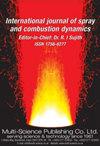The effect of an axial mean temperature gradient on communication between one-dimensional acoustic and entropy waves
IF 2.1
4区 工程技术
Q3 ENGINEERING, MECHANICAL
International Journal of Spray and Combustion Dynamics
Pub Date : 2018-06-01
DOI:10.1177/1756827717743910
引用次数: 8
Abstract
This work performs a theoretical and numerical analysis of the communication between one-dimensional acoustic and entropy waves in a duct with a mean temperature gradient. Such a situation is highly relevant to combustor flows where the mean temperature drops axially due to heat losses. A duct containing a compact heating element followed by an axial temperature gradient and choked end is considered. The proposed jump conditions linking acoustic and entropy waves on either side of the flame show that the generated entropy wave is generally proportional to the mean temperature ratio across the flame and the ratio ( F - 1 ) , where F is the flame transfer function. It is inversely proportional to the Mach number immediately downstream of the flame M2. The acoustic and entropy fields in the region of axial mean temperature gradient are calculated using four approaches: (1) using the full three linearised Euler equations as the reference; (2) using two linearised Euler equations in which the acoustic and entropy waves are assumed independent (thus allowing the extent of communication between the acoustic and entropy wave to be evaluated); (3) using a Helmholtz solver which neglects mean flow effects and (4) using a recently developed analytical solution. It is found that the communication between the acoustic and entropy waves is small at low Mach numbers; it rises with increasing Mach number and cannot be neglected when the mean Mach number downstream of the heating element exceeds 0.1. Predictions from the analytical method generally match those from the full three linearised Euler equations, and the Helmholtz solver accurately determines the acoustic field when M 2 ≤ 0 . 1 .轴向平均温度梯度对一维声波和熵波通信的影响
本文对具有平均温度梯度的管道中一维声波和熵波之间的通信进行了理论和数值分析。这种情况与平均温度由于热损失而轴向下降的燃烧室流动高度相关。考虑一个包含紧凑加热元件的管道,其后是轴向温度梯度和阻塞端。所提出的火焰两侧声波和熵波连接的跳跃条件表明,所产生的熵波通常与火焰的平均温度比和比值(F - 1)成正比,其中F为火焰传递函数。它与火焰M2下游的马赫数成反比。采用四种方法计算轴向平均温度梯度区域的声场和熵场:(1)以完整的三个线性化欧拉方程为参考;(2)使用两个线性化的欧拉方程,其中假设声波和熵波是独立的(从而允许评估声波和熵波之间的通信程度);(3)使用忽略平均流效应的亥姆霍兹求解器;(4)使用最近发展的解析解。结果表明,在低马赫数条件下,声波与熵波之间的通信很小;它随着马赫数的增加而增大,当加热元件下游平均马赫数超过0.1时,它不可忽略。解析方法的预测结果通常与全部三个线性欧拉方程的预测结果相匹配,亥姆霍兹解算器准确地确定了m2≤0时的声场。1 .
本文章由计算机程序翻译,如有差异,请以英文原文为准。
求助全文
约1分钟内获得全文
求助全文
来源期刊

International Journal of Spray and Combustion Dynamics
THERMODYNAMICS-ENGINEERING, MECHANICAL
CiteScore
2.20
自引率
12.50%
发文量
21
审稿时长
>12 weeks
期刊介绍:
International Journal of Spray and Combustion Dynamics is a peer-reviewed open access journal on fundamental and applied research in combustion and spray dynamics. Fundamental topics include advances in understanding unsteady combustion, combustion instability and noise, flame-acoustic interaction and its active and passive control, duct acoustics...
 求助内容:
求助内容: 应助结果提醒方式:
应助结果提醒方式:


